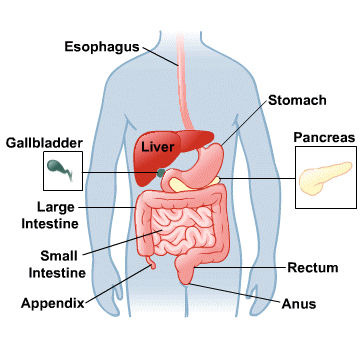There is the lyric "Just a spoonful of sugar...", but how you swallow that sugar at the first place and what will happen to it afterwards. Our digestive system is responsible for digesting the food that we consume and extracting what we need to support our body to carry out day-to-day actions. Now let's get closer to know more about the functions of digestive system and how many organs are involved.
Digestive System Functions
If you want to know the functions of digestive system, you should know which organs are involved and what are their functions in the digestive process.
1. Mouth
The first part of the digestive system is mouth which is the primary entry point of food consumption. The teeth chew the food which breaks it up into small, more easily digestible pieces. The saliva present within your mouth mixes with the food to start the process of digestion.
 2. Esophagus
2. Esophagus
The esophagus is the gateway for food to enter your stomach from your mouth, which can be found in your throat, near the windpipe. It uses muscular contractions (known as peristalsis) to deliver the food from your mouth to your stomach.
3. Stomach
When the chewed food has passed through the mouth and the esophagus, it reaches the stomach where the food is broken down into usable substances and forms. The breaking down is achieved through stomach acid which is released from the cell lining of the stomach and powerful enzymes which help to further break down the food.
4. Small Intestine
The food then moves from the stomach to the small intestine, once they have been sufficiently processed. The small intestine is a long muscular tube that releases enzymes to further break down the molecules. Small intestine can be divided into 3 sections: the duodenum, jejunum and ileum. The continuous break-down process is mainly achieved in the duodenum, while the jejunum and ileum provide the bloodstream with nutrients which are obtained from the food. Once the content has passed through the lower intestine, it is transformed from a semi-solid state to liquid form due to the break-down process and the enzymes released.
5. The Colon, Rectum and Anus
The colon, rectum and anus provide an important digestive system function. These are known as the lower GI tract, and are solely responsible for producing and excreting solid waste from food that has been consumed.
Once food has been processed and passed through the small intestine, the waste that cannot be used by the body is moved to the colon where it is transform into solid waste (feces). The colon is made up of four parts: the ascending colon, transverse colon, descending colon and sigmoid colon. From the colon the waste substance is moved and stored in the rectum. Once this delivery is achieved, a signal is sent to the brain which triggers the need of excreting the solid waste. Then the feces are released through the anus.
6. Accessory Digestive Organs
Although named accessory digestive organs, each organ listed below is important to efficient digestive system function.
- Pancreas creates the enzymes that are released into the small intestine (duodenum) which break down carbohydrates, fats and proteins.
- Liver processes the blood to remove any waste and impurities and secretes bile to aid digestion in the small intestine.
- Gallbladder: The bile made in the liver is not always required by the small intestine. In that case, the excessive bile is stored in the gallbladder and will be used latter. The bile has 2 functions: aiding in absorbing fats in foods and carrying wastes form liver that can't go through the kidneys.
Where Do Digested Food Molecules Go?
Most digested food molecules are absorbed in the small intestine and then enter the bloodstream which then carries the useful molecules around the body to perform various functions. Simple sugars, glycerol, amino acids and some vitamins are transported via bloodstream to the liver and other body parts.The lymphatic system, a network of vessels, absorbs fatty acids and carries them, along with lymph and white blood cells, throughout the body.
What Controls the Digestive System?
The digestive system is controlled by two types of regulators: hormone and nerve.
- Hormone regulators are created in the small intestine and stomach lining cells. Their purpose is to control appetite and promote the production of digestive juices, essential to maintain your proper digestive system function.
- Nerve Regulators are made up of both intrinsic and extrinsic nerves. The intrinsic nerves are activated when food pushes the walls of the organs within the GI tract. Intrinsic nerves release many chemicals that regulate the speed of the digestive process. Extrinsic nerves connect the organs of the digestive system to the spinal cord and the brain. The nerves release a substance that causes the muscle layer within the GI tract to contract or relax (dependent on whether there is food to be digested or not).
